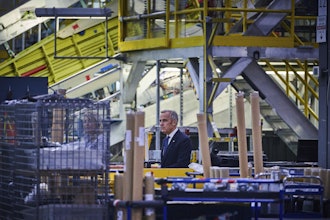This article originally appeared in the May/June 2012 issue of Industrial Distribution. To view it in its original format, click here.
When it comes to best practices, nobody will tell our audience what’s “best” without first looking at the external economic conditions, the state of the government (including taxation and health care), access to cash, product availability, employee relationships, and more. That said, there are some key areas where our survey respondents were in agreement as to what most effects their strategy, and how they plan to continue to remain competitive.
Quality once again tops the list when it comes to the most important criteria our survey takers say they consider when evaluating suppliers. In fact, quality’s place of importance on a distributor’s list hasn’t changed in any marked way over the past four years (Figure 1, right). What’s interesting to point out is how this emphasis refuses to dwindle, even during the most economically challenging years we’ve seen in several decades.
Figure 1: Which do you consider to be the most important criteria when evaluating suppliers? |
One of the more interesting trends is shown in Figure 1, where it’s clear that on-time delivery and price have declined steadily on the list of priorities. The only category to show any measurable growth has been in the service/support arena, where our survey respondents show a gradual increase in service and support requirements. As shown in Figure 1, 56 percent of respondents cited this area as critical in 2009, whereas that group is at 61 percent today. Terms (not shown) showcased the largest decrease in the past several years, with 33 percent calling this critical in 2009, compared to only seven percent today. Since respondents were permitted to “check up to three,” it’s likely that terms are important, just not as much as other areas when it comes down to priority.
One interesting area to note in the results was in the slight increase in emphasis on the reputation of suppliers. Up by five percent from 2011, 32 percent of respondents see this as one of the most important criteria.
When it comes to support, most (51 percent) said the service levels they’ve received over the last year from their suppliers have remained unchanged. Last year, 48 percent of survey respondents said the same. The most notable result to this question relates to those who said supplier service levels have “gotten worse.”
Last year, 31 percent said supplier service levels were on a downswing from the year previous, whereas that figure dipped to 25 percent when comparing 2012 to 2011. Twenty-one percent said supplier service levels had improved from 2009 to 2011, a group which remained stable in 2012.
Figure 4: Which of the following have your suppliers offered to help reduce costs? |
Overall, results have been fluctuating when it comes to the analysis of these relationships. When asked “How has the relationship with your suppliers changed in the past year?” Fifty-six percent said it’s stayed the same—a minor increase from the 51 percent who said this last year. It’s evident, however, that the static nature of this relationship is an improvement in and of itself, considering 18 percent of last year’s group said their relationships had gotten worse since the year previous. This one-in-five has diminished to one-in-eight who say the relationships have gotten worse, with nearly identical results in those who say the relationships have improved (33 percent). In short, more economic stability is likely improving the strength of these relationships, as many distributors see improving access to capital and a bit more slack in their budgets and margins, as are their suppliers. The influence of the externalities, like a deflated economy and more cost pressures, likely added stress to business dealings that today’s distributor is more able to roll with.
“Many vendors are making it more difficult to return slow or non-moving product.”
We asked our survey respondents to clarify why they think these relationships have gotten better or worse For those who have seen improved relationships, it’s because of “More engagement on both sides,” said one respondent. Another distributor echoed the point, citing “More sales and support people” as the reason. Another suggested it’s because “Suppliers are more in tune to our needs.” For those on the positive trend, it appears the economic downturn may have created some tangible reasons for their manufacturer-suppliers to look hard at how they could participate in the relationship in a way that might sustain these (often) long term relationships.
Other distributors were not so lucky, and cite a take-it-or-leave it type attitude from their suppliers. “Vendors want to do less for your business and are more concerned with their bottom lines,” said one respondent. “Also, many vendors are making it more difficult to return slow or non-moving product.” Others felt the source of the problem was suppliers leaning more on distributors to carry a disproportionate amount of the burden. “Our supplier is expecting us to handle more of their work,” said one distributor.
Added another, “They are relying on distribution more and more.” Other points speak to a decline in customer service—likely the result of recession-era job cuts for many manufacturers — as well as other employment gaps: “They have been hiring college grads that do not know the products and do not realize the importance of customer relationships,” said one survey taker. Another cites a lack of production employees which causes lead times to suffer.
Other respondents intoned on loyalty. “Manufacturers seem to be easily jumping from one rep group to another at the drop of a hat.” Another claims the climate has simply changed to be “less about the distributor and more about market share.”
While the reasons for the tensions within these relationships are varied, it likely doesn’t help that suppliers continue to increase their prices year over year. In fact, 97 percent of you said your prices have gone up, a statistic that falls in line exactly with what we heard last year (Figure 3). While this is often viewed as the cost of doing business, it can spark serious resentments, considering what we know about how these increases are met from distributors. According to our March Profits & Pricing Report, 81 percent of ID survey respondents pass price increases along to their own customers, something they say causes them to work harder to retain existing business. This oftentimes results in distributors being forced to change the terms of the discussion towards overall value of the relationships, putting added pressure on them to invest in their service capabilities. While 34 percent said they were able to negotiate with their suppliers to help offset the price increases, over a third also said there were instances in the previous year where they’d been forced to absorb the price increases themselves.
It appears that some suppliers are trying to soften escalating prices by adding value-added services, although only a third of you say you’ve been the recipient of such efforts. This result is unchanged from last year’s survey. Out of this pool the majority see efforts from a co-op marketing or advertising standpoint. Other areas that ranked high include new product introductions and technical assistance. Only one in five say they occasionally receive price breaks, and 22 percent said an elimination in stocking fees or easier return policies were offered.
Other unique options suppliers have been offering to unburden the distribution channel include reducing shipping fees or drop shipping, something 31 percent of those receiving services said they were offered.
Ultimately, the shifts from the heart of the recession are evident. In 2009, 59 percent of survey respondents said suppliers who were offering ways to reduce overall costs for distributors were doing so by lowering prices. An astonishing drop (to 19 percent) suggests that the position of power in these relationships has shifted again, harkening to the take-it-or-leave it attitudes we spoke about earlier in this section. What they’re not offering in lowered prices, suppliers seem to be trying to make up for in technical assistance and co-op marketing, two categories where the increase has also been quite dramatic.
Figure 6: Of the following, which best describes your global business interests? |
Whether suppliers are successful in softening their price increases through additional value add remains to be seen. What we do know is that for most of your suppliers, their place in your supply chain is by no means guaranteed. Our Profits & Pricing Report cited a large majority of distributors who evaluate their supplier base once per year or more. In fact, of the nearly 74 percent of ID survey respondents who do, 41 percent say they reevaluate these business partners more than once per year. On the other end of the spectrum, 21 percent say they evaluate their suppliers every few years, and only five percent say they never do.
And whether these responses to cost pressures are the right ones, it seems distributors aren’t always taking their own customers wants and needs into account either. When asked whether they conducted customer feedback surveys, our survey respondents were split 50-50 between those who do and those who don’t. So if they don’t, how are they determining whether they’re getting the customers exactly what they need? Some are likely using feedback gained piecemeal from account reps and customer service departments, although distributors should be encouraged to establish more consistent methods for gathering data, especially as tensions dominate these business relationships.
Survey respondents gave us some additional details about their internal initiatives:
- Fifty-six percent say they share point-of-sale information with their manufacturers and suppliers. This has been steady, if not declining by fractions, since 2008. Large distributors are most likely to make this information available.
- Over 65 percent of respondents say they have an internal recycling program in place, up by nearly four percent since last year. The increase here has been rapid, as 50 percent said the same in 2009.
- When it comes to doing business overseas, we see a trend that continues to incrementally decline. According to our 2008 results, nearly 2/3 (63 percent) of our respondents said they were doing business abroad. Fifty-five percent said the same in 2009, 54 percent in 2011, and 51 percent today. There are myriad reasons for this shift, but much of the downward slope is likely due to high tariffs, transportation costs (most notably fluctuating oil prices), quality issues, and response times/delivery problems — many of which have ramifications from both a procurement side and for those selling into global markets.
“Manufacturers seem to be easily jumping from one rep group to another at the drop of a hat.”
Another interesting trend here is the decline in companies who plan to do business outside the U.S. in the coming years. While 11 percent said they had these plans in 2007, the group incrementally condensed to seven percent saying the same in 2009 and less than six percent now saying they have immediate global business interests (Figure 6). Those who said “Not now; no plans” was a group of 36 percent last year, and now is up to just over 40 percent. This shift could potentially result from a growing disenchantment with global selling based on the aforementioned management issues. Others may have simply reigned in expansion objectives during the recession, in which case we may see this group begin to expand again as cash flow improves and distributors begin to feel more stable in their domestic operations.























